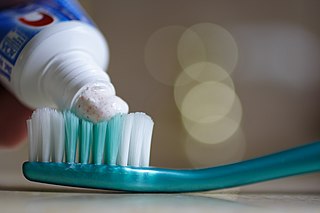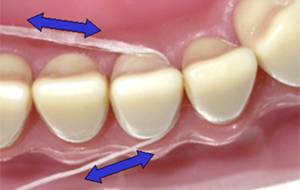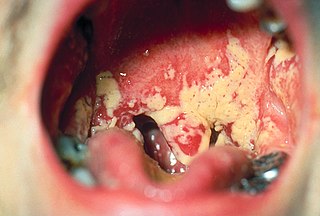Related Research Articles

Toothpaste is a paste or gel dentifrice used with a toothbrush to clean and maintain the aesthetics and health of teeth. Toothpaste is used to promote oral hygiene: it is an abrasive that aids in removing dental plaque and food from the teeth, assists in suppressing halitosis, and delivers active ingredients to help prevent tooth decay and gum disease (gingivitis). Owing to differences in composition and fluoride content, not all toothpastes are equally effective in maintaining oral health. The decline of tooth decay during the 20th century has been attributed to the introduction and regular use of fluoride-containing toothpastes worldwide. Large amounts of swallowed toothpaste can be toxic. Common colors for toothpaste include white and blue.

Xylitol is a chemical compound with the formula C
5H
12O
5, or HO(CH2)(CHOH)3(CH2)OH; specifically, one particular stereoisomer with that structural formula. It is a colorless or white crystalline solid that is soluble in water. It can be classified as a polyalcohol and a sugar alcohol, specifically an alditol. The name derives from Ancient Greek: ξύλον, xyl[on], "wood", with the suffix -itol used to denote sugar alcohols.

Tooth decay, also known as cavities or caries, is the breakdown of teeth due to acids produced by bacteria. The cavities may be a number of different colors from yellow to black. Symptoms may include pain and difficulty with eating. Complications may include inflammation of the tissue around the tooth, tooth loss and infection or abscess formation.

Dental floss is a cord of thin filaments used in interdental cleaning to remove food and dental plaque from between teeth or places a toothbrush has difficulty reaching or is unable to reach. Its regular use as part of oral cleaning is designed to maintain oral health.

Streptococcus mutans is a facultatively anaerobic, gram-positive coccus commonly found in the human oral cavity and is a significant contributor to tooth decay. It is part of the "streptococci", an informal general name for all species in the genus Streptococcus. The microbe was first described by James Kilian Clarke in 1924.

Fluoride therapy is the use of fluoride for medical purposes. Fluoride supplements are recommended to prevent tooth decay in children older than six months in areas where the drinking water is low in fluoride. It is typically used as a liquid, pill, or paste by mouth. Where public water supplies are fluoridated further fluoride by mouth is typically not needed. Fluoride has also been used to treat a number of bone diseases.
Toothfriendly International is a non-profit association which was established in 1989 in Basel, Switzerland. The purpose of the association is to advance oral health, particularly through preventive measures which include regular oral hygiene, appropriate dietary habits and regular check-ups by a dentist. It is governed by an executive board of dental professionals.
The Happy Tooth is a registered trademark of Toothfriendly International. It stands for guaranteed toothfriendly quality.

Early childhood caries (ECC), formerly known as nursing bottle caries, baby bottle tooth decay, night bottle mouth and night bottle caries, is a disease that affects teeth in children aged between birth and 71 months. ECC is characterized by the presence of 1 or more decayed, missing, or filled tooth surfaces in any primary tooth. ECC has been shown to be a very common, transmissible bacterial infection, usually passed from the primary caregiver to the child. The main bacteria responsible for dental caries are Streptococcus mutans and Lactobacillus. There is also evidence that supports that those who are in lower socioeconomic populations are at greater risk of developing ECC.

Oral microbiology is the study of the microorganisms (microbiota) of the oral cavity and their interactions between oral microorganisms or with the host. The environment present in the human mouth is suited to the growth of characteristic microorganisms found there. It provides a source of water and nutrients, as well as a moderate temperature. Resident microbes of the mouth adhere to the teeth and gums to resist mechanical flushing from the mouth to stomach where acid-sensitive microbes are destroyed by hydrochloric acid.

Oral hygiene is the practice of keeping one's mouth clean and free of disease and other problems by regular brushing of the teeth and cleaning between the teeth. It is important that oral hygiene be carried out on a regular basis to enable prevention of dental disease and bad breath. The most common types of dental disease are tooth decay and gum diseases, including gingivitis, and periodontitis.
Ortek Therapeutics, Inc. is a private healthcare company based in Roslyn Heights, New York which specializes in researching and commercializing oral care products. It was founded in 1998.

Tooth remineralization is the natural repair process for non-cavitated tooth lesions, in which calcium, phosphate and sometimes fluoride ions are deposited into crystal voids in demineralised enamel. Remineralization can contribute towards restoring strength and function within tooth structure.

Daintee is a company based in Sri Lanka that produces confectionery and other food products. It is the market leader in confectionery sales in Sri Lanka.
The Hall Technique is a non-invasive treatment for decayed baby back (molar) teeth. Decay is sealed under preformed crowns, avoiding injections and drilling. It is one of a number of biologically orientated strategies for managing dental decay.

Tooth wear refers to loss of tooth substance by means other than dental caries. Tooth wear is a very common condition that occurs in approximately 97% of the population. This is a normal physiological process occurring throughout life; but with increasing lifespan of individuals and increasing retention of teeth for life, the incidence of non-carious tooth surface loss has also shown a rise. Tooth wear varies substantially between people and groups, with extreme attrition and enamel fractures common in archaeological samples, and erosion more common today.
Silver diammine fluoride (SDF), also known as silver diamine fluoride in most of the dental literature, is a topical medication used to treat and prevent dental caries and relieve dentinal hypersensitivity. It is a colorless or blue-tinted, odourless liquid composed of silver, ammonium and fluoride ions at a pH of 10.4 or 13. Ammonia compounds reduce the oxidative potential of SDF, increase its stability and helps to maintain a constant concentration over a period of time, rendering it safe for use in the mouth. Silver and fluoride ions possess antimicrobial properties and are used in the remineralization of enamel and dentin on teeth for preventing and arresting dental caries.
Hans Rudolf Mühlemann was a Swiss dentist and medical academic. He was professor and director of the Dental Instituts University of Zurich.
Interdental cleaning or interproximal cleaning is part of oral hygiene where the aim is to clean the areas in between the teeth, otherwise known as the proximal surfaces of teeth. This is to remove the dental plaque in areas a toothbrush cannot reach. The ultimate goal of interproximal cleaning is to prevent the development of interproximal caries and periodontal disease. The combined use of tooth brushing, and mechanical and manual interdental cleaning devices has been proven to reduce the prevalence of caries and periodontal diseases.
Topical fluorides are fluoride-containing drugs indicated in prevention and treatment of dental caries, particularly in children's primary dentitions. The dental-protecting property of topical fluoride can be attributed to multiple mechanisms of action, including the promotion of remineralization of decalcified enamel, the inhibition of the cariogenic microbial metabolism in dental plaque and the increase of tooth resistance to acid dissolution. Topical fluoride is available in a variety of dose forms, for example, toothpaste, mouth rinses, varnish and silver diamine solution. These dosage forms possess different absorption mechanisms and consist of different active ingredients. Common active ingredients include sodium fluoride, stannous fluoride, silver diamine fluoride. These ingredients account for different pharmacokinetic profiles, thereby having varied dosing regimes and therapeutic effects. A minority of individuals may experience certain adverse effects, including dermatological irritation, hypersensitivity reactions, neurotoxicity and dental fluorosis. In severe cases, fluoride overdose may lead to acute toxicity. While topical fluoride is effective in preventing dental caries, it should be used with caution in specific situations to avoid undesired side effects.
References
- ↑ Imfeld T. (1983). Identification of low caries risk dietary components in: “Monographs in Oral Science”. Vol. 11: 1-198. Myers H.M. (ed.), Karger, Basel.
- ↑ WHO, World Health Organization Technical Report Series, Geneva, 1984, no 713, p.19.
- ↑ T.Imfeld and B.Guggenheim (1991) Sugarless - the Way Forward. A.J. Rugg-Gunn (ed.), Elsevier Applied Science, London 1991, p. 197.
- ↑ De Paola D.P. (1986). Executive summary. Proceedings of scientific consensus conference on methods for assessment of the cariogenic potential of foods. J. Dent. Res. 65 (Spec. Iss.): 1540-1543.
- ↑ Firestone A.R., Imfeld T., Schiffer S. and Lutz F. (1987). Measurement of interdental plaque pH in humans with an indwelling glass pH electrode following a sucrose rinse: A long-term retrospective study. Caries Res., 21: 555-558.
- ↑ Imfeld T. (1983). Identification of low caries risk dietary components. In: "Monographs in Oral Science". Vol. 11: 1-198. Myers H.M. (ed.), Karger, Basel.
- ↑ Igarashi K., Lee I.K. and Schachtele Ch.F. (1989). Comparison of in vivo human dental plaque pH changes within artificial fissures and at interproximal sites. Caries Res., 23: 417-422.
- ↑ Schachtele Ch.F. et al. (1986). Human plaque acidity models - Working Group Consensus Report. J. Dent. Res. 65 (Spec. Iss.):1530-1531.
- ↑ Lussi A., Jaeggi T. and Zero D. (2004). The role of diet in the aetiology of dental erosion. Caries Res., 38 (1): 34-44.
- ↑ Stösser L., Tietze W., Künzel W. and Limberger K. (1990). Intra-orale pH-Messung zur Bestimmung des azidogenen Potentials von Nahrungsmitteln. Oralprophylaxe, 12: 145-153.
- ↑ FDA (1997). Food and Drug Administration. Letter from J.J. Saltsman, (CFSAN) to D. McColl (Hyman Phelps & McNamara), 2 July 1997.
- ↑ ESFA Journal 2011;9(4):2076
- ↑ ALÜ (1989). Ausschuss Lebensmittelhygiene und Lebensmittelüberwa-chung. Ergebnisprotokoll betr. lebensmittelrechtliche Bewertung der "Aktion Zahnfreundlich e.V.". Sitzung vom 7./8. November 1989.
- ↑ ACCC (1997). Final assessment issued by the Australian Competition & Consumer Commission in regard to Certification Trade Mark Application Nos. 572400 to 572402 (inclusive) and 601904 - Aktion Zahnfreundlich.
- ↑ International Dental Federation (FDI) (2000). Consensus Statement on Diet of 2nd World Conference on Oral Health Promotion. Int. Dent. J., 50(3): 174.
- ↑ • Riva Touger-Decker and Van Loveren C. (2003). Sugars and dental caries. Americal Journal of Clinical Nutrition; 78 (suppl) 881S-92S.